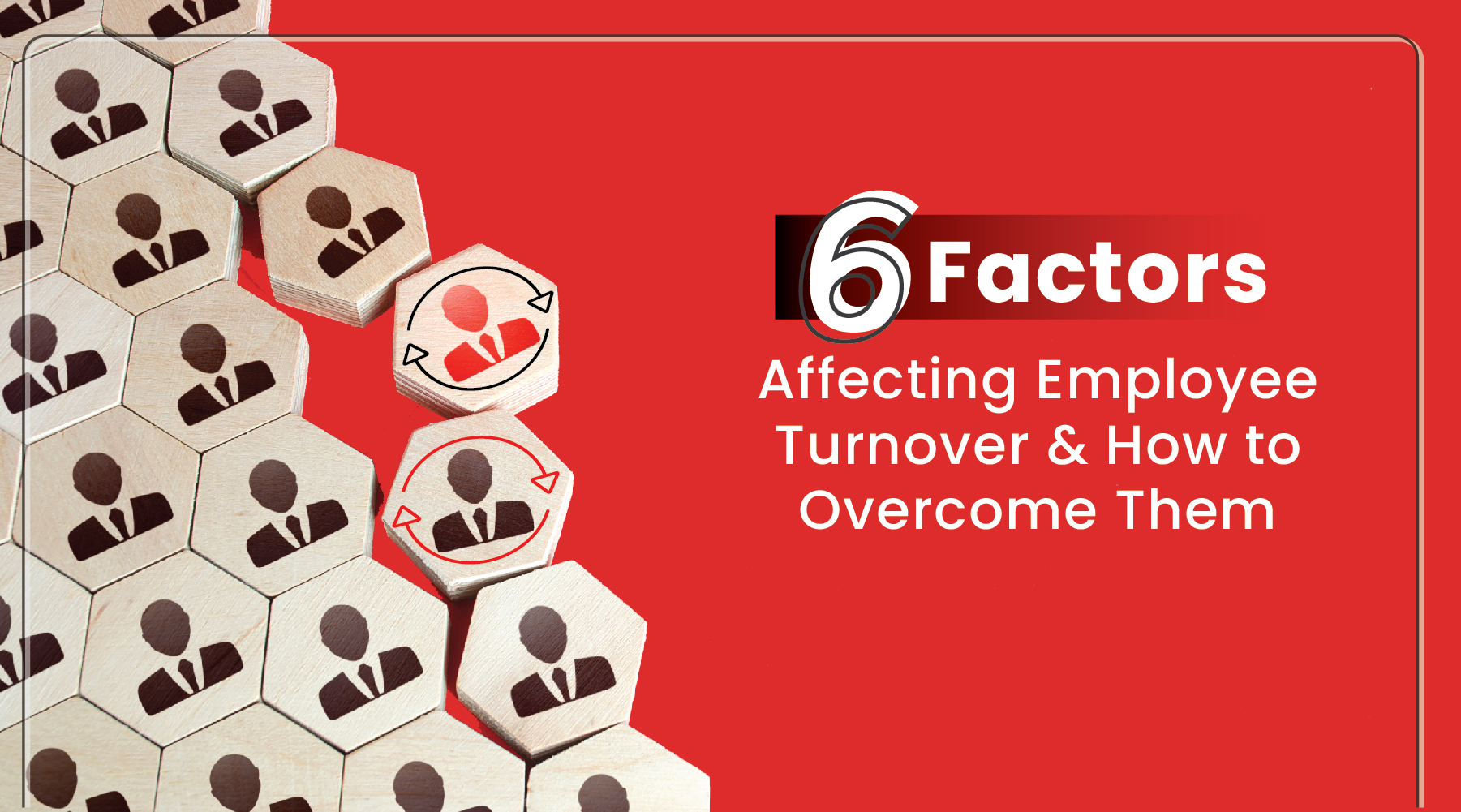One of the biggest problems companies regardless of industry, sector, or even size struggle with is employee turnover. And there are many factors affecting employee turnover, many of which stem from within the company itself.
Some industries have higher turnover of employees than others, like call centers, for example.
What companies don’t realize is that employee turnover is costly and affects them negatively. It also affects their employees, their productivity, and the company’s annual revenues.
To understand this problem better, let’s clarify what employee turnover is, the factors affecting employee turnover the most, and how companies can reduce their turnover.
What is employee turnover?

what is employee turnover?
Employee turnover is the average number of employees who leave a company during a specific time frame.
The employee turnover rate isn’t always a bad thing. It can be “a good indicator of an organization’s work culture, the effectiveness of hiring policies, and overall employee management,” explains Forbes.
However, a high employee turnover isn’t a good thing. It can indicate one or more of the following problems:
- Hiring policies may be ineffective
- Bad managers or management
- Presence of favoritism which drives people away
- Lack of hierarchy and/or pay structure
- Job descriptions are inconsistent with the actual job roles
These are a few of the reasons that may result in employees quitting a company. We’ll discuss the factors affecting employee turnover in more detail in the sections below.
Other terms to refer to employee turnover
When discussing employee turnover, it’s important to mention other terminologies that refer to this concept. According to Power Thesaurus, there are over 10 ways to do so. They are:
- Turnover/turnover rate(s)
- Movement of staff/staff movement
- Employee exit workflow
- Personnel turnover/movement of personnel
- Rotating staff/staff rotation/rotation of staff/rotation of personnel
- Turnover factor
- Staff turnover/turnover of staff
Employee turnover statistics in the Middle East

employee turnover statistics in the middle east
There are many reasons why employees leave. These reasons are increasing in number not becoming fewer. This primarily because of the misalignment between what employees and job seekers want and what businesses want.
A PwC survey in June 2022 found that 30% of employees in the Middle East were ‘extremely likely’ or ‘very likely’ to search for a new job in the next year. This is higher than the global percentage of 19%.
Since 2020, the hiring market has been volatile. First, because of COVID-19 and then because of the rebound, reports PwC. Moreover, the pandemic made many employees, especially full-timers, realize the benefits of working remotely.
But with many companies resuming a full-time in-person work situation, it 100% suitable for today’s employees.
According to PwC, there’s a “mismatch between employees’ and employers’ expectations […] in the Middle East.”
Employers want to go back to the old way of full-time in-house work, while employees prefer remote or hybrid work situations.
Nearly 31% of employees surveyed by PwC said their companies wanted them to work from the office on a full-time basis. “Across all demographics, only 23% stated that this was their preferred method of working.”
Factors affecting employee turnover

6 factors affecting employee turnover
Now it’s time to zoom in on what makes employees quit. The following are the top factors that cost companies money and employees.
1) Better pay
This is probably the top reason why employees leave companies and move to others: better salaries.
With fast-increasing inflation and cost of living, it’s no surprise many employees look for higher salaries and move to jobs that offer them exactly that. But not all companies can offer competitive salaries.
However, one way companies can remain competitive is to offer additional benefits for employees. This doesn’t mean offering low salaries with wow benefits. It simply means giving employees other reasons to stay besides the salary increase.
A common mistake employers make when employees choose to leave for higher pay is that they offer them the salary they chose to receive from their new employer.
While this may seem like a good retention strategy, it often hurts the trust between the company and its employees. The employee’s first thought is: ‘If I’m worth the higher salary, then why are they only giving it to me when I choose to leave?’
2) Lack of motivation
Another factor of employee turnover is the lack of motivation. This can stem from a role where the company promised employee development opportunities but there were none. Or due to the monotony of certain roles.
To overcome this, companies and especially HR teams should work on creating employee engagement opportunities.
3) Bad management
Another major reason behind high employee turnover is bad management. This could be within a specific team or department or across the whole company.
Bad management often results in favoritism, which makes employees feel that no matter how hard they work, someone less qualified will always get better perks, better KPIs, and so on.
A company with bad management will often see employees’ relationships suffer both with other employees and with the company itself.
Having HR and work policies that not only suit the company but also support employees’ needs can reduce employee turnover. Done right, these policies should ensure a bad manager is unlikely to remain in their position for long.
“An understanding of turnover rate compared to industry standards as well as global employee retention benchmarks can help businesses drive growth and improve workforce engagement.” – Forbes
4) Remote vs in-house work
As mentioned, many employees are looking for remote or work-from-home opportunities. The lack of these jobs, especially in Egypt and several countries in the Middle East, results in employees taking jobs with the intent to leave as soon as they find a remote alternative.
That’s why some companies offer a hybrid work situation as a mid-way option between full-time remote work and full-time in-person work.
Moreover, the younger the generation, like Gen Z, the more employees prefer working remotely, PwC revealed. Roughly 43% of Gen. Z respondents in the Middle East cited the remote or ‘mostly remote full-time arrangement’ as their preferred work arrangement.
Only 15% were in favor of a full-time in-house work situation. This shows the growing gap between employers and employees.
5) Absence of growth opportunities
Employees don’t join companies so that they can maintain their same role for years and decades. All employees want to grow within a company and their career.
A company with little to no growth opportunities is one with a high employee turnover. If employees can’t advance in your company, why should they stay?
6) Lack of appreciation
A commonly-cited reason behind high employee turnover is the lack of appreciation. Employees don’t feel appreciated when they overcome major obstacles or milestones for the companies they work for.
Similarly, many companies promise financial bonuses but never give them. This makes employees feel unappreciated and prompts them to leave.
As a company, helping your employees create work-life balance goes a long way into making employees feel appreciated. Offering good compensation packages, employee rewards,…etc. prompts employees to stay.
How to calculate cost of employee turnover
Calculating the cost of employee turnover isn’t easy. And it primarily differs based on industry and role.
Most businesses calculate their employee turnover rate on either a quarterly or annual basis. Some companies, especially those looking to develop their HR strategy, may calculate the turnover of new employees to see how effective, or ineffective, their hiring policies are.
Industry is a factor that affects salaries and accordingly turnover. For example, oil and gas companies tend to pay higher salaries than other industries because:
- Employees have to travel for several months
- Dangerous work environment
Geographical location is another factor that affects salaries and accordingly the cost of employee turnover. Some geographical locations within the same country can mean higher salaries than others.
For example, if you’re a business operating in Egypt, you’ll find companies operating out of Cairo and Giza offering higher salaries across the majority of roles. Meanwhile, companies operating from other governorates or cities offer less.
There are exceptions for tourist-focused governorates like Hurghada and Sharm El Sheikh.
How to reduce employee turnover
Now that we’ve covered the top factors affecting employee turnover, let’s explore ways to reduce the number of employees leaving your company.
- Ask employees, regularly, how the company can make their jobs easier and better.
- Develop their soft and hard skills.
- Offer monetary incentives such as bonuses for top-performers.
- Offer non-monetary incentives such as additional time off, flexible working hours,…etc.
- Offer employee incentives such as paying a portion of their tuition or online courses.
- Recognize employees who participate in volunteer activities.
- Engage employees with volunteer initiatives that contribute to supporting their local communities.
- Recognize your employees on social media.
- Celebrate achievements using a Wall of Fame or a company newsletter.
- Create an HR strategy that takes employees’ needs into consideration
- Avoid the top hiring mistakes employers make.
- Outsource some of your administrative tasks to reduce the pressure of multitasking on your employees.
- Use salary surveys to be able to offer competitive salaries to current and future employees.
- Use psychometric tests to upskill your employees and make better hiring choices.
Conclusion
Many businesses today struggle with employee turnover. However, many of them don’t realize that the problems are internal.
While salaries remain one of the top reasons behind high employee turnover, they’re not the only factor.
Luckily, and as you’ve seen there are many ways to reduce employee exits. You can carry out one or more of these methods in-house.
Or you can work with an expert in HR and employee management like Tawzef to improve your HR strategy and work on retaining your employees.
Feel free to contact us and our specialized team will help you.



























































































































